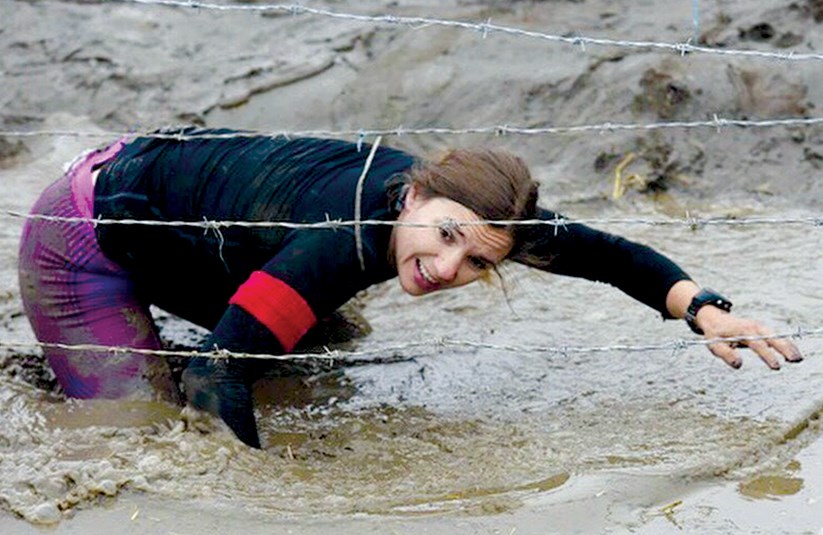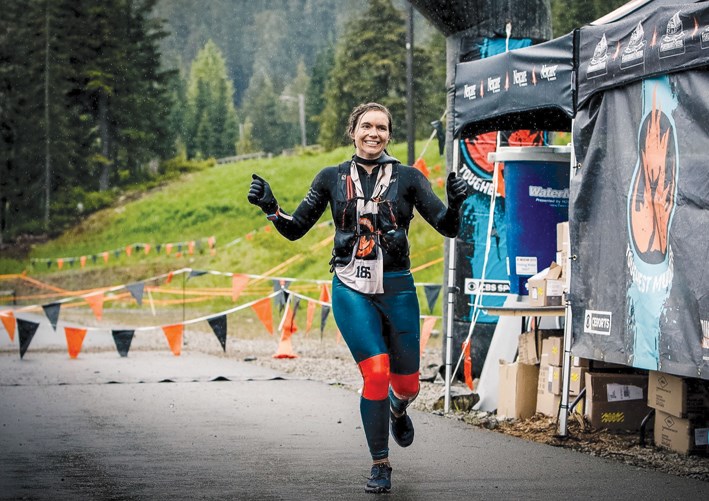About a kilometre into her second lap Michelle Ford was heading into the most technical part of the loop when she lost her headlamp.
She recalls her thought at that moment: “Oh shoot, I’m going to be in trouble.”
Ford had another headlamp at the next pit station but she would have to fumble through the dark for the following hour until she got there. Then a stranger from
New Zealand came to the rescue. He stayed alongside her for most of the lap to make sure she had enough light.
“I can’t tell you how appreciative I was of him,” says Ford.
Thanks to her fellow runner’s help, she didn’t fall behind and went on to finish second in the Toughest Mudder obstacle race.
The event, which took place in Whistler on June 17, required participants to complete as many loops as they could of an eight-kilometre lap during an eight-hour period from midnight to 8 a.m. Ford finished seven laps in total.
Each loop featured a variety of obstacles, 19 per lap, mostly involving water.
One of Ford’s favourites was an obstacle called Hang Time, which involved racers climbing a five-metre platform, jumping four feet to catch a metal T-bar, and swinging over to reach a cargo net to climb over a pool of water.
“The goal is to not get wet and fall into the pool,” explains Ford.
This was only the second time Ford participated in the Toughest Mudder event.
Two years ago, she was at the World’s Toughest Mudder but had to drop out due to injury 10 hours into the 24-hour race. The recent Whistler event was a qualifier for the World’s in Las Vegas in November, so Ford will get a second chance to finish what she started.
“I really like challenges,” she says of why she competes in the unique obstacle races. “There’s something super exhilarating about being five hours into a race and knowing that you still have all these heavy carries and these big steep climbs and swims you have to get through, and I just get into this meditative state and I just get so much joy out of it.”
A week before the Whistler qualifier, Ford also ran both the five-kilometre and 11-kilometre Spartan races at Mount Seymour June 10-11.

“It’s such an amazing feeling,” she says of racing. “My strength comes towards the end of the race, and I just love that feeling of being my strongest at the end of a challenge.”
An athlete her whole life, Ford was a competitive gymnast when she was younger. Later she went to art school and “dabbled in the art world” a bit before returning to her athletic roots.
She picked up running about six years ago when she signed up for a 50-kilometre race and decided the best way to train for a 50k was to train for a marathon, which she also ran.
Trail running and ultra-running are popular sports on the North Shore, and Ford says the community of runners is one of the reasons she loves it. Although she doesn’t have a preference between trail running and road running (her training includes both), she admits there is a special camaraderie that occurs during trail races.
“If you’re hiking up a hill usually you’re making friends with the person who’s suffering next to you,” she notes.
Training these days involves running five to six days a week, often starting at Mosquito Creek Park, which is right by her home. She also works out at a gym three to four times a week, and heads to a climbing gym on top of that to work on her grip strength.
Ford says the keys to success in this type of racing are to avoid over-training and just enjoy the whole experience.
“You need passion, but also you need to be able to have fun. I think that’s a huge thing for me, to have fun and still be able to be determined.”



